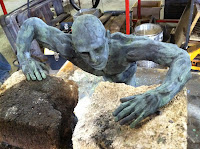A patina is the exterior
color of metal. It is the result of a chemical reaction with the metal
that literally changes the surface color and it can be either natural,
man-made or both.
Luke Voytas is applying a cold patina of diluted flat black rustoleum enamel to his aluminum casting that provides depth and brings out the texture. This can be buffed back to highlight high and lows.
Senior Danny Van Winkle applies ferric nitrate to aluminum to give the affect that the diving helmet is made of heavy iron. One the ferric is washed off he is then applying some cupric nitrate to provide the sense of algi and history. It looks like it has been under the sea for eons!
Each one of Caleb Fletcher's eye collection has a different patina combination: blacks, blues, browns, reds and yellows are applied so each one is unique. The color was chosen to reflect the eye color of loved ones.
Cast Iron : first sandblasted and a light coat of ferric nitrate is sprayed on and washed off with water to give one overall even color. Life Body Cast by Senior Caleb Fletcher
Senior Sarah May spend several hours buffing and polishing the Cast Iron to achieve this beautiful mirror effect. Start with a coarse grit and sanding and polishing in a circular motion up to a 500 grit, eventually using a buffing pad and buffing polish.
A Patina can make all the difference once the sculpture is in its natural setting: here the aluminum casting takes on the natural colors in the landscape : one of mud, wood, leaves but resiliently standing up against the wear of life. Installation in the creek by Senior Caleb Fletcher.
 |
The Bronze casting is cleaned and sandblasted before the patina process. This way the chemical can react just to the metal. It is important that there is no grease or other chemicals on the surface before you start.
For this heat patina: Senior Casey Duer applies several coats, starting with liver of sulphide, then ferric nitrate, both with a spray bottle. Then on top of that he carefully applies cupric nitrate with a brush to create a dappling affect.
 |
| Peter Leone, brass centrifugal casting |
 |
| Hannah Crowl : 'Acuputure' Cast Iron and copper pins |
Applying a patina to work can add context, color, enhance texture and meaning. It can add character and history, it can make an object appear more precious, ornate and delicate.
A great example of a natural patina can be seen on
the Statue of Liberty. The beautiful green color is the result of
decades of air and moisture reacting with the copper. A natural patina
usually develops over a man-made patina that was applied by the artist
during the casting process.
Patinas are traditionally applied
with brushes or a spray bottle where the sculpture is heated to 200f
heat, but patinas can be applied in various ways : such as boiling,
burying, painting, plating, and wrapping the sculpture with chemical,
paint or other substances that will affect and change its color. . Once
the desired color is achieved the sculpture is rinsed with cold water to
stop the chemical reaction. Once the desired color is achieved two
coats of wax or laquer are applied to the sculpture while it is still
warm to seal the patina.
Different chemicals react with different metals
to achieve different colors. One of the most common patinas on broonze is Liver of
Sulfur (potash) which results in a golden-brown to almost black color.
Other chemicals include Ferric Nitrate (golds, browns and reds) and
Cupric Nitrate (greens and blues). They can also be used in layers to
achieve a variety of artistic effects.
Follow this link : Silver Nitrate Patina Where you will see a
complex patina application using high temperature red enamel engine
paint, silver nitrate and soot. For further research and tutorials
visit the Sculpt Nouveau You Tube Channel.


















